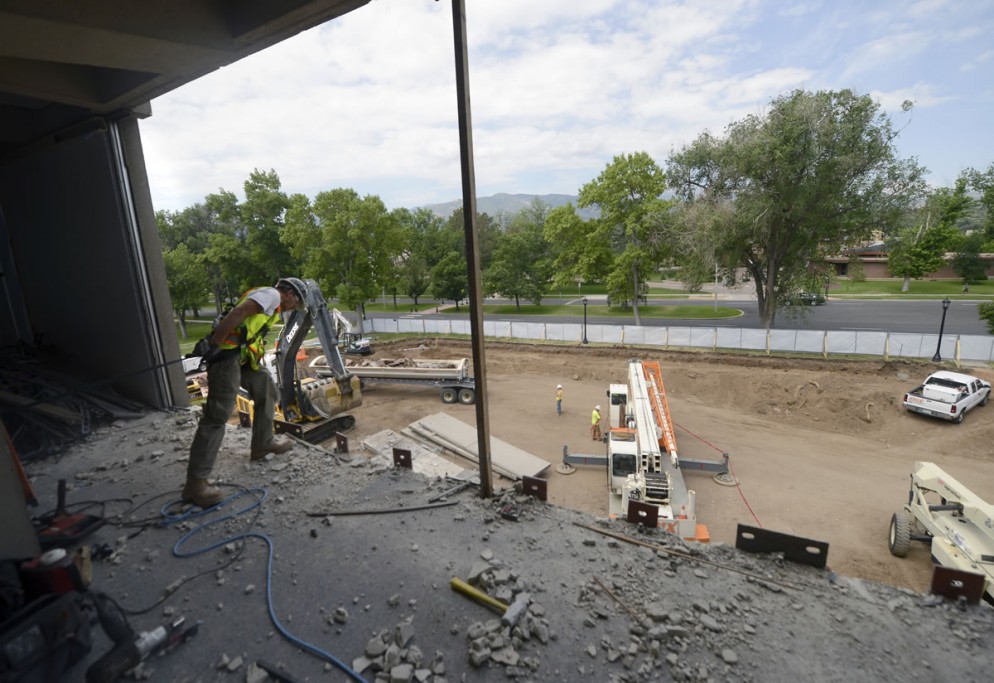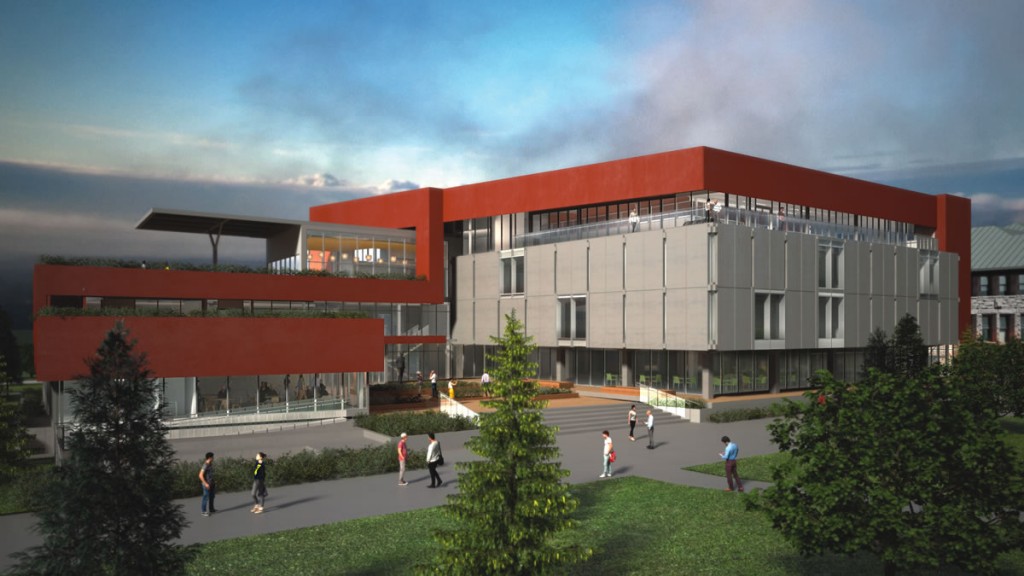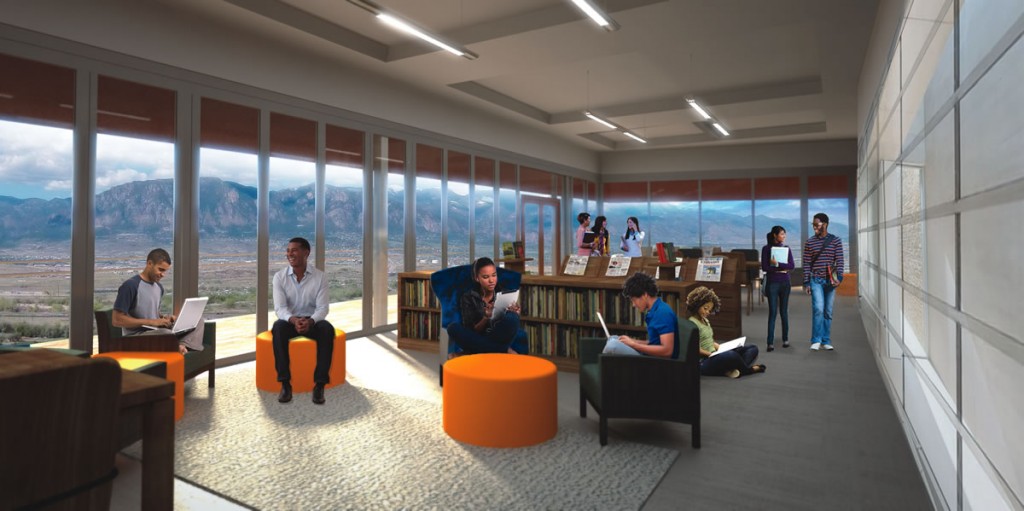Library Renovation Supports Learning on the Block Plan as it Enhances Sense of Place
A first-of-its-kind space, intentionally designed to provide additional support to CC’s pioneering Block Plan, is under construction at Tutt Library. The new library will serve as the intellectual hub of the campus, as well as a physical home for the Center for Immersive Learning and Engaged Teaching.
Allowing for technology-equipped seminar rooms, study space, and group collaboration rooms, as well as a café, the new building aims to bring the campus community together in both structured and unstructured ways. Being flexible to engage both faculty and student interests will be the key to the physical — and academic — space offered within CC’s new library, which is scheduled to open in August 2017.
The renovation preserves some elements of the original structure, while creating a new space that supports collaboration and increases access for all students. The new building will house some 1,100 seats. That’s more than double the 495 seats available in the current library.
An increase in capacity doesn’t only apply to seating: CC’s sustainability efforts are also gaining a big boost from the project. While the word “library” may not invoke visions of sustainability powerhouses — a facility of its type is still stocked with shelves and shelves of dead trees — when it comes to the future of Tutt Library, that’s exactly what the campus will be getting.
The renovated library will enhance CC’s distinctive sense of place, supporting the college’s strategic initiative to be recognized as a model of environmental stewardship and innovation by advancing both the study and the practice of sustainability. Every detail of the project — from the architecture to the construction process — is conducted through the lens of sustainability.
When complete, the new Tutt Library will be a major player in fulfilling CC’s goal of reaching campus carbon neutrality by 2020.
“This is the coolest project I’ve worked on,” says Ian Johnson, CC’s sustainability director. “This is ground- breaking for me, and for, I think, colleges in general.”
“The scale of this is what makes it so cool, the scale of it and the operation,” he adds. “This is basically a 24/7 building, 90,000-plus square feet. To be a carbon-neutral building — it’s never actually been done before that we can find, not in a library of this scale. This is kind of a first, especially at an institute of higher ed.”
When it came to the whole package — everything from building envelope performance, to indoor air quality, to artificial lighting, and more — the Campus Sustainability Council and the Office of Sustainability weighed in heavily on the decision to make the new library a net-zero energy building. One of the key pieces to this will be its continuous loop geothermal heating and cooling system, which uses the thermal mass of the earth to both warm and cool the building.
“Essentially in summertime the system works like a large air conditioner,” Johnson says. “But instead of dumping heat into the air, like a window A/C unit does, we’re dumping that heat into a water loop that’s pumped through the ground.”
The earth absorbs the excess heat, which cools the water to make its way back up for another pass and absorb more heat that the system is rejecting into the ground.
In the winter, the process reverses. Heat that’s been stored during the summer gets transferred back up and through the building. “It’s somewhat of an HVAC miracle,” Johnson says with a laugh.
To make all of this happen, CC needs a grid of 80 vertical wells drilled down 400 feet. Along with the big transfer of books, journals, and other materials to the temporary Creekside facility at the northwest edge of campus, it was one of the first parts of the project to begin in May right after Commencement 2016. And though it might seem like an expensive ordeal, in the big picture, it’s not for the total $45 million expansion and renovation that will add a modern design, open-concept indoor study space, outdoor terrace space, and expansive views of Pikes Peak.
“One of the questions that people like to ask is, ‘What’s the payback on something like this geothermal deal?,’ ” says Johnson. “There’s not a great answer for it, and I’ll tell you why: because we designed this building as a full system, almost a living, breathing system. And because we did that, the additional costs were relatively low. I think it was about two percent of the total cost of the project. If we were to take an existing building, or if we had remodeled the library and then decided we wanted it to be net-zero, the costs would be exceptionally higher and the payback would normally not be feasible.”
The geothermal system is just one of the new library’s sustainability features. The entire facility is being designed and modeled as a zero-carbon building (ZCB). That means it will produce zero annual net carbon emissions with zero net energy (natural gas and electricity) consumption. The total energy consumed by the building on an annual basis is roughly equal to the amount of projected renewable energy provided to the local grid.
Even the trees that had to be removed to accommodate the new library’s foundation will be repurposed. Scott Johnson, associate professor of studio art and director of studio programs, plans to transform one of the largest trees into a sculptural form that will “speak to the memory of its growth through the years.” He also preserved a cross section of each tree that was removed, with plans to host an exhibit of the trees in the new library. Scott Johnson and his students took notes, detailing such things as each tree’s geographic location and orientation, so that the project could showcase the cross sections at the exact locations in the new library where the trees once stood.
What Ian Johnson says has him most jazzed about this project is seeing all the players who have a vested interest in building a new library with this type of emphasis.
“It’s defining, with so many things around here, of the ethic of support for sustainability on campus, from the architects to the engineers we consulted with, to our facilities folks, to the folks actually working in the library. I think that’s super telling of where we’re at as an institution, our own development level around sustainability.”
Stephanie Wurtz, director of internal communications, contributed to this article.
Visit the “Tutt in Transition” website for regular updates about the project, architectural renderings, lots of photos, and 24/7 live webcams of the renovation.



